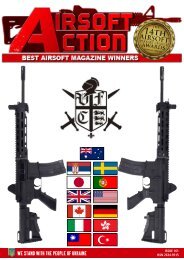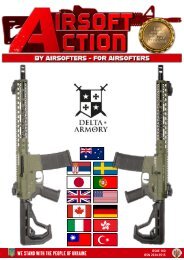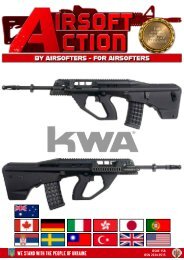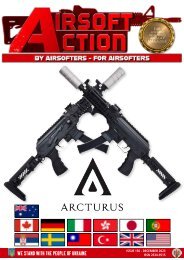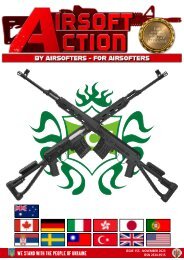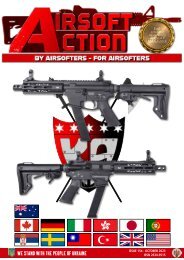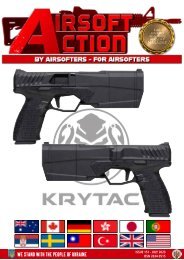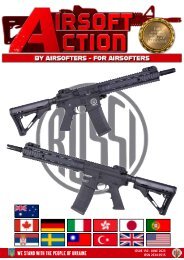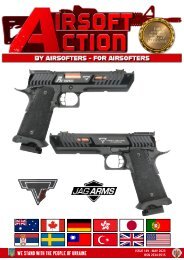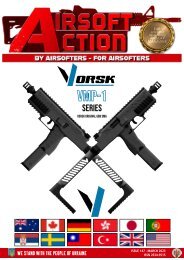PMCI - May 2021
It's that time again and even though parts of our world are still ravaged by COVID, Bill and Trampas have pulled out the stops to get another issue of PMCI up and online! The world doesn't stop turning, and neither do they stop "getting work done" as PMCI gets inside the doors of the cutting-edge WOFT Training Facility in the USA and has a look at what G&G Armament are doing with the Taiwanese Military in terms of "6MM Training" for the real world. While Trampas gets on the range with the SIG M18, whilst Bill turns his attention to packs and plate carriers; it may be hard to get stuff done right now, but as always PMCI deliver something for everyone when it comes to "tacticool"!
It's that time again and even though parts of our world are still ravaged by COVID, Bill and Trampas have pulled out the stops to get another issue of PMCI up and online! The world doesn't stop turning, and neither do they stop "getting work done" as PMCI gets inside the doors of the cutting-edge WOFT Training Facility in the USA and has a look at what G&G Armament are doing with the Taiwanese Military in terms of "6MM Training" for the real world. While Trampas gets on the range with the SIG M18, whilst Bill turns his attention to packs and plate carriers; it may be hard to get stuff done right now, but as always PMCI deliver something for everyone when it comes to "tacticool"!
Create successful ePaper yourself
Turn your PDF publications into a flip-book with our unique Google optimized e-Paper software.
weather scenario. “Big Packs”, or in military parlance, “Bergans”,
for winter use are a whole other ballgame, and although many of
the principles are the same they are beasts with a character and
temperament all of their own, and deserve to be treated with
utmost respect!
Choosing the best “patrol pack” is a difficult and personal
thing, and there is no single definitive answer as to what will
be best for you, but ultimately it’s all about getting the job done
safely and efficiently; there is simply “no one fits all” patrol pack
that will suit every individual, and it all really comes down to how
you’re planning to use it
For any situation that’s going to involve more than you
can carry in your pockets, you’re going to need a pack! Even a
sustainment pack fitted to the back of your plate carrier will help,
and as much as I love these, I will usually opt for a standalone
pack for a number of reasons. You may think that “all packs are
equal” but they actually have lots of functional differences. I am
of the opinion that even one pack will not be adequate for all
scenarios, and even as a believer in “light is right” I have multiple
packs for different scenarios; having two to three dedicated packs
can cover you for pretty much any scenario you find yourself in,
and although you can wing it with a single model, having more
than one allows you more choice, and more tactical flexibility.
Are you a person that likes to cover all the bases, one that
is prepared for any kind of weather that “Old Ma Nature” may
throw at you, the player that’s prepared to bivvy at the drop of a
hat? To begin to work out what size and type of pack is right for
you, first think about the following:
• Fit: This is paramount to me for a tactical pack; if it weren’t I
could just drag around a big old trash bag containing my worldly
goods!
• Role: How you’ll use the your pack, and in what setting, can
will give you an idea of the features you’ll need
• Capacity: Just HOW MUCH gear are you going to be lugging (ask
yourself why; do you REALLY need it all!)
• Features: How many pockets do you need, and why? How easy
is the pack to access? How easy is it to dump if you need to bug
out fast?
Patrol packs come in all sizes, great and small, so when you’re
thinking about what you need to buy, REALLY think about what
you need to have in it. Can the pack swallow up a box or two of
ammo, a cleaning kit, some snacks, and water for a day on the
range? Will it be large enough to carry and extra layer and your
waterproofs on a bad-weather day? Do you need to carry any
specialist items like comms? Let’s look at things by size first!
• Up to 10 litres : These can be great for a range day where you
just need to have a few choice essentials, and are usually pretty
stable as most models will be designed for hi-speed pursuits
where little bulk or weight is really carried. They’re great if you
can head back to the car whenever you need to, but at any other
time you’ll be wanting something bigger!
• 10–20 litres: This is my “go to size” if I’m going to be working
close to a base or from vehicles, as generous re-supply will still
be relatively close at hand. At the larger end of this spectrum a
20 litre pack will let you carry additional shell garments, a more
substantial FAK, and more food and water so you can sustain
yourself for a longer period if needed
• 20–45 litres: When it comes to multi-day training scenarios
then this is where I look to have enough packed on my back
to last, with occasional re-supply of rations and water, for some
considerable time! I’ve gone into packing lists for multi-day
scenarios before, but the 40-45 litre mark is where this really
clicks into gear for me; you can go smaller if you’re REALLY superminimalist,
but around 40 litres is the absolute sweet spot as far
as I’m concerned!
KEEPING THINGS STABLE
You’ll find that many smaller, lightweight packs do an excellent
job of adapting to the shape of your back, and if you’re in 0-20
litre territory you can make do with very little mechanical support
as part of the pack construction. When you move up in size, and
therefore potentially in the weight that you may carry though, you
need a little help to get the right fit and correct support that will
help you avoid discomfort and fatigue! Many mid-size packs have
an internal frame that helps support the weight you’re carrying;
some will have plastic parts that add lightweight structure, whilst
others will make use of alloy rods or staves to support the load.
Bottom line; the sturdier the frame, the more the pack, and
you, can handle safely and comfortably!
But the framework of the pack is only the beginning of
getting the “fit” right, and your pack should be as individual in
how it interacts with your body as you are! A good pack “fit” will
give you the correct size appropriate for your torso length (NOT
your height), and will offer support via the hip belt which should
be a snug fit if it’s a padded version such as those you’ll find on
larger models; for the smaller, low-volume, low-weight packs the
hip belt can be more minimal and is really there for stability.
You’ll find that some mid-size packs are available in multiple
sizes to fit a range of torso lengths, and that ranges vary by
manufacturer and by gender. While trying frame-packs on,
position the hip belt so the top edge is just above your hips, then
look at how the shoulder straps work on your back and shoulders
themselves; with no weight in the pack, the straps should sit
slightly proud of your shoulders, enough that you can slip a finger
beneath without feeling pressure, as when you add weight the
straps will be pulled down. If there is a big gap the pack is likely
too long for you! If at all possible try on your potential new loadpartner
with some weight in; most good stores or outfitters will
have weight bags specifically for this. Some packs feature an
adjustable torso that lets you really dial-in the fit; if you struggle
to find the right fit with other packs, consider one with an
adjustable torso. This is also a good idea if you’ll be sharing the
pack with someone too!
KIT: PACKS
pmcimagazine.com




